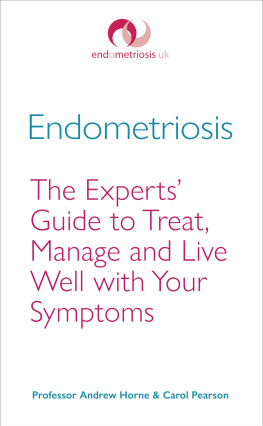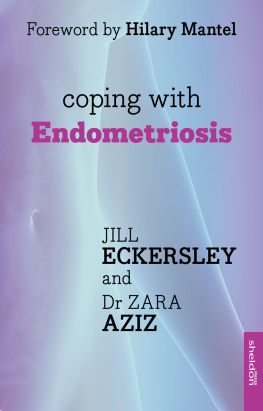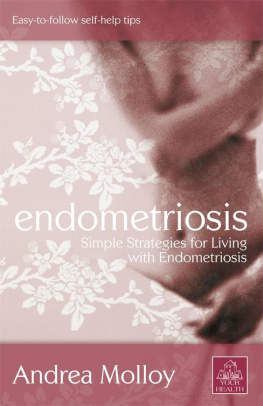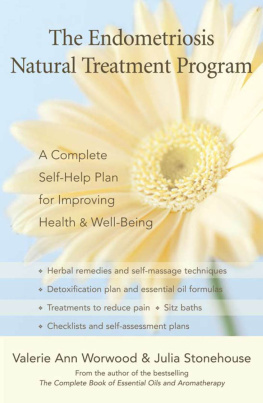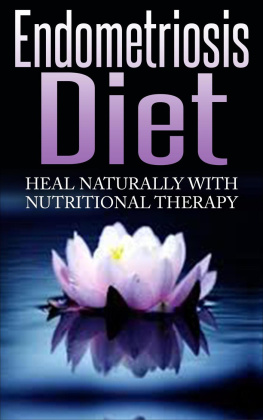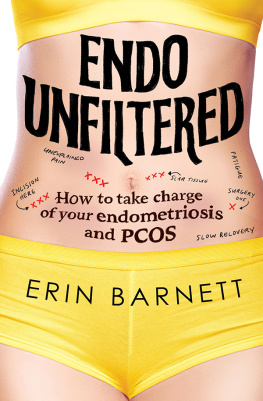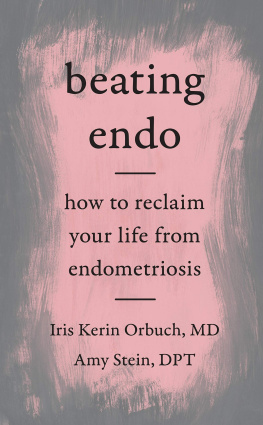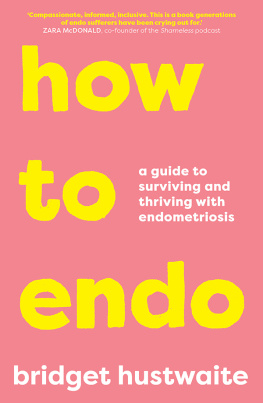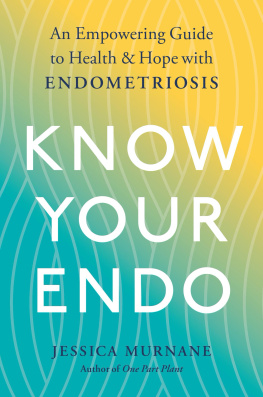Contents
About the Book
All the information you need to live well with endometriosis
Endometriosis experts Professor Andrew Horne and Carol Pearson present the latest research and advice to help you manage your symptoms and take back control of your body and your health. They also share first-hand experiences of women who have overcome the pain, frustration and isolation associated with endometriosis to live a full and happy life. Find out:
- How to get a diagnosis
- What treatment options and care are available to you
- Lifestyle changes that could improve your condition
- How to overcome your symptoms and live a better life
About the Author
Professor Andrew Horne (PhD FRCOG) is an internationally renowned endometriosis expert and Professor of Gynaecology and Reproductive Sciences at the University of Edinburghs MRC Centre for Reproductive Health.
Carol Pearson has been involved with Endometriosis UK for many years and delivered a TEDx talk on endometriosis, Rewriting Red Riding Hood, after her career was cut short due to the disease.
Endometriosis UK is the UKs leading endometriosis charity and provides vital support services, reliable information and a community for those affected by endometriosis.
www.endometriosis-uk.org
To all women with endometriosis, may your voices be heard so that future generations will have real hope of answers, an easier diagnosis, better treatments and even a cure, and to the healthcare professionals who dedicate their careers to helping women with endometriosis despite the many challenges thank you for not giving up
Foreword
Endometriosis is not straightforward. It is a disease where cells similar to those lining the womb grow elsewhere in the body. Where they grow, how much they grow, how deep they grow, and what they interfere with will vary from person to person and so each individual with the disease experiences a different range of symptoms, and to a different severity. Despite affecting 10 per cent of women of reproductive age 1.5 million in the UK, 176 million worldwide there is no cure, and treatments are not always helpful and can come with risks or side effects.
The average length of time to get a diagnosis is, shockingly, 7.5 years. Being an average this masks a significant range from women who receive great support and are diagnosed in just a few months because their GP suspects endometriosis early on and navigates the route to diagnosis efficiently, through to women for whom diagnosis takes 15 years or more. Before a diagnosis, effective treatment options cannot easily be offered. Before a diagnosis, a woman may be told her symptoms are normal, may be misdiagnosed with another condition, or may even be told her symptoms are in her head. They may miss work or education, unable to put a name to their problems, hampering their careers endometriosis costs the UK economy an estimated 8.2bn a year in treatment, loss of work and healthcare costs. This is no way for women to be treated in the 21st century.
There is no doubt that endometriosis can sometimes be a challenge to diagnose and to treat. Symptoms are shared by a range of other conditions chronic pelvic pain can be associated with pelvic inflammatory disease, fibroids, irritable bowel syndrome and painful bladder syndrome, to name just a few, as well as due to endometriosis. Endometriosis doesnt always show up on scans and the only definitive diagnosis at present is through surgery, so it makes sense to rule out other conditions first if that can be done less invasively. But endometriosis should be considered when a woman has one or more symptoms, and sadly that doesnt always happen.
There are steps that we can take to significantly reduce diagnosis times and improve the treatments women are offered. Raising awareness of menstrual health and whats normal as part of education in schools, so no-one puts up with years of pain and other problems thinking its normal. Raising public awareness after all, this affects 10 per cent of women irrespective of race or socioeconomic background, so shouldnt everyone know about it? We need tools and guidance to help GPs, as well as wider availability of resources to treat women effectively, so women dont have to wait months sometimes years for surgery they very much need. Investment in research is vital to find answers about what causes endometriosis and effective treatments.
Vitally important, we need to support women with endometriosis, or who suspect they might have it, to ensure they have the information and support they need to help manage their condition. And this is where this book comes in; we hope it will provide help to women, and all those that support them, to navigate through their journey with endometriosis.
Many thanks to Carol Pearson and Professor Andrew Horne, our authors. Together they have produced this expert guide through their knowledge and many years of experience working with and championing the needs of women with endometriosis, bringing together the voices of patients and clinicians.
Emma Cox,
CEO, Endometriosis UK,
2017
Introduction
Imagine that you spend months no, lets make that years, maybe many years in pain, excruciating pain, but you think, or are told, that what youre going through is normal. You wrack your brain for answers. It doesnt add up. Something is not right! You know it, but others cant see it, even people that youre really close to.
You seek help, seeing one doctor, then another, you try this drug and then that one, but youre not getting better you get referred to a hospital and the same routine starts over again. You have one invasive test or scan followed by another, and still no answers. Finally, someone operates And, one day you are told that you have a disease called endometriosis.
But you havent heard of it nor has your partner, your mother or your friend. Later, youre back at work or college and though you tell them it still hurts, no one understands. You have more surgery arent you better yet, everyone says? No, youre not. You start more treatment, have more surgery, you feel a bit better but then it comes back again and so it goes on.
If you were told that this was a disease that affected one in 10 women, and yet this story still goes on all over the world today, you would be deeply shocked. How can this happen? Womens bodies womens problems have been so taboo and this silence has cost society.
In the many years that we have both been involved supporting or looking after women with endometriosis, we have heard this story literally hundreds of times. The stories invariably involve women who have experienced a delay in diagnosis; they often involve women seeing a whole range of healthcare professionals and having an array of tests and several maybe even many surgeries. They involve many years of suffering, sometimes with a positive ending, but not always.
Our book provides up-to-date information on endometriosis and the latest treatments available, linked to real stories of many women with endometriosis. We want you to hear about the stories of these women women who have often hidden their suffering and tried desperately to live normal lives. How the women coped, what were the highs and lows, what impact did this disease have on them their relationships, their fertility, their careers and their hopes and dreams? We want to show you not just the women behind this disease but also their partners, their family members and the GPs, gynaecologists, nurses, and allied healthcare practitioners who work so hard to treat women with endometriosis, because their stories are part of that fabric too. These women they could be you, or your partner, sister, daughter or mother, or they could be your patient, sitting patiently telling you again that they are in pain whoever they are, they must be listened to.

